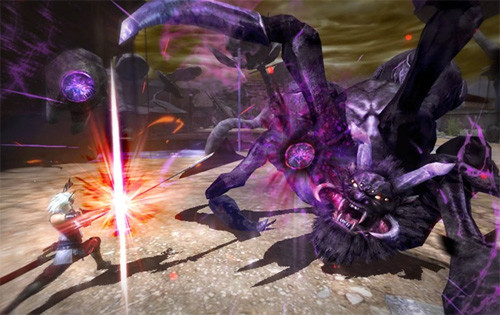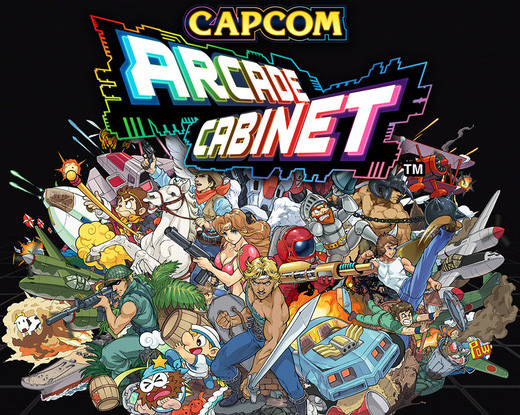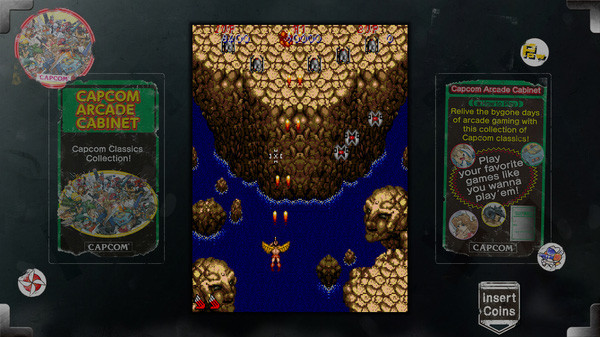The X Button
Arcade of My Youth
by Todd Ciolek,

Tomorrow is Valentine's Day, so I thought it best to begin this column with the most romantic scene in any video game: the ending of Ghosts 'N Goblins for the NES.

This is also relevant to the main feature this week. See, back in the days of the NES, we couldn't get perfect ports of arcade games. Some developers didn't even try to remodel their arcade hits and just created largely new games with the same ideas. This actually improved things in several cases, giving us the NES editions of Bionic Commando, Ninja Gaiden, and Rygar. Other games weren't so lucky, and Ghosts 'N Goblins was one of them. Its NES incarnation is a puny, frustrating imitation of the grueling title that tormented many arcade-goers of the mid-1980s, and it actually adds even more typos to the game's ending.
This is no longer a problem in our modern era, and getting an arcade-perfect Ghosts 'N Goblins will be even more convenient with this new CAPCOM Arcade Cabinet. Yet we've lost that entire art of remaking an arcade title into something superior. Oh well.
NEWS
WE MIGHT GET A REAL CLASS OF HEROES 2 AFTER ALL
Remember that ill-fated Kickstarter for a deluxe Class of Heroes 2 release? Well, it's still alive. Gaijinworks and MonkeyPaw Games launched a poll to see if fans will buy a packaged PSP release of Class of Heroes 2. The digital version of the game will run $24.99 on the PlayStation Network, but MonkeyPaw plans a physical release (plus a download code) for $34.99 if enough buyers promise to pick it up.

The Gaijinworks website needs at least 2500 pledges by Thursday, and at this writing the count is within 100 entries signatures of that goal. So Class of Heroes 2 might not need our help, but I'd hate to see this thing fall sort by just a few buyers.
Why should you support it? I can think of two reasons. One, Class of Heroes 2 looks like an enjoyable dungeon hack that improves on the admittedly flawed original. Two, a UMD release might mark the second time Gaijinworks' Victor Ireland has backed the last material game for a system. It'd have a place in history next to Magic Knight Rayearth for the North American Sega Saturn.
OMEGA FORCE'S TOUKIDEN TAKES SHAPE
Omega Force makes one Dynasty Warriors game after another, interspersed with anime-based games very similar to Dynasty Warriors. But every now and then Tecmo KOEI lets the developer out to do something a touch different. Omega Force's latest such excursion is Toukiden, which seems to be the developer's response to Monster Hunter.

Toukiden unfolds several years after some temporal cataclysm spewed a host of demons across the human world, leaving a few resolute hunters to beat back the menace. The player controls one of these hunters, with a variety of weapons and accessories at hand. The game's built for the Vita and PSP, and it allows up to four players to join battles against giant demons. Sound like Monster Hunter? Sure does. Toukiden's out later this year in Japan, and Tecmo KOEI's usually good about releasing Omega Force's titles over here. They brought out Trinity: Souls of Zill O'll, after all.
GHOST IN THE SHELL BECOMES A BRAIN-JACKING, ROBOT-PUNCHING ONLINE RPG
That new Arise thing isn't the only upcoming Ghost in the Shell installment. Nexon, publishers of the MapleStory online games, are creating Ghost in the Shell Online, a first-person shooter in which players can customize their cyborg components and hack into opponents' brains. It'll have Motoko, Batou, Tachikoma tanks, and the rest of Section 9 as playable characters, and it'll be out in Japan next year.

That's all we know for now. I'm mentioning it mostly so I can show this illustration of Batou punching off a robot's head. I hope it's not promising something the actual game won't deliver.
FEATURE: THE CAPCOM ARCADE CABINET
The arcade has long since fallen from its perch as the defining standard of the game industry, but there was indeed a time when the best-looking titles were not on your home console or PC. They were in bowling alleys, laundromats, grocery stores, Chuck E. Cheeses and those poorly lit dens of game cabinets that parents warned children about. Arcade titles were important back then, and I think CAPCOM's trying to evoke just a bit of that with their latest venture.

The CAPCOM Arcade Cabinet service presents at least 15 of the company's older titles on Xbox Live and the PlayStation Network, and we're promised arcade-exact versions of the games right down to the DIP switches and other operator features. Multiple display options are available for each title, along with HD optimization, “casual” modes, and those achievements that the kids seem to prize so much. These games should be the same as they were in the arcade…and as they presently are on the MAME emulators that most of us have been using for over ten years.
Yes, the Arcade Cabinet technically isn't anything new, and it's not even the first time CAPCOM has repackaged its coin-op hits for modern systems. Yet it's a convenient bundle that lets players pick and choose their favorite pieces of CAPCOM's early arcade heritage, and many of these pieces are worth picking again. Games ship on a weekly basis between next week and May 17 with a complicated pricing structure. At first they'll be $9.99 for each three-pack, and two weeks later those same games will be available individually for $4. Wait until the very end of the schedule, and you can pay $29.99 for the whole set and two extra titles.
FEBRUARY 19: BLACK TIGER, 1943: BATTLE OF MIDWAY, AVENGER
CAPCOM's giving away Black Tiger (below) for free during the Cabinet's debut week, though Xbox Live users can't use continues on their gratis version of the game (thus simulating that time your well-meaning grandmother dropped you off at the arcade with only one quarter to last two hours). This works out well because Black Tiger's the highlight of the first round. Predicting a lot of trends in CAPCOM's later titles, it's an action-platform game where a barbarian hero slays monsters and upgrades his weapons on the way up a tower. Black Tiger never got a crack at a wider audience, as CAPCOM canceled an NES version of the game. But it'll be free to any PlayStation Network and Xbox Live users next week.

Among the remaining two games, 1943: Battle of Midway is a decent shooter that caused a little controversy in Japan back in the 1980s (given its World War II setting). Avengers is…well, it's an overhead action game where a street thug pounds his way through a rival gang. It's interesting mostly as a precursor to Final Fight and the other brawlers that CAPCOM would disgorge copiously into arcades not long afterward.
MARCH 5: GUN.SMOKE, GHOSTS 'N GOBLINS, SECTION Z
The leader this week is Ghost 'N Goblins (below), CAPCOM's legendarily hard side-scroller. Its hero Arthur can take only two hits during his quest to save a princess (inventively named “Prin Prin” here), and the game's designed to deliver those hits at every opportunity. And then it makes you play through everything a second time. Persevere, and you'll see some rather sharp level design for a mid-1980s arcade beast, even if there's not much room to enjoy it.

Gun.Smoke, with its copyright-defusing period, is a vertically scrolling Wild West shooter notable for its experimental controls. Players direct their fire by holding three different buttons in various combinations, allowing for some interesting strafing techniques. Section Z is an average space shooter from 1985, and it clings a bit too close to the standards of an earlier arcade era.
MARCH 19: SIDE ARMS, THE SPEED RUMBLER, EXED EXES
The Speed Rumbler (a.k.a. Rush & Crash) is one of the more obscure choices in this lineup, but it's a good one. As close as CAPCOM ever got to making a Mad Max game, The Speed Rumbler is a vertical driving-shooter that pits a lone hero and his car against a band of road warriors. Players can get out of the vehicle for on-foot combat (or roll from it as it explodes), and the whole thing is hectic fun. Like Black Tiger, The Speed Rumbler (below) was in line for an NES port that never came, so the Cabinet's a good way to make up for that. Fire up the Road Avenger theme song if you need to get in the mood.

Side Arms is also a standout: a respectable side-scrolling mech shooter with a fairly elaborate power-up system. Exed Exes, on the other hand, is apparently here for historical value. It's one of CAPCOM's earliest arcade shooters (but not the earliest; that'd be Vulgus), and it gets a bit repetitive once you've faced a few flights of robotic bees.
APRIL 2: COMMANDO, LEGENDARY WINGS, TROJAN
Commando is the most influential of this week's selections, as its vertically scrolling approach to on-foot shooting influenced dozens of arcade and console titles. As an actual game, it's tough, short, and not all that well-designed. That's history for you. Trojan also has its place, and the game's post-apocalyptic backdrops are impressive even when the side-scrolling combat isn't.

I admit to having a certain fondness for Legendary Wings (above), though it's not really on account of the gameplay. It suffers from limited power-ups and punishing stage design, and it uses that annoying Xevious system where one button fires aerial shots and another launches ground attacks. No, I just like Legendary Wings for the sheer strangeness of it. You're a winged warrior coasting above ruins that are part Greek and part Babylonian, and shortly into the first stage a giant Stone Head appears and swallows you into a side-scrolling underworld if you fly too close. The original U.S. version of the game replaced the winged Michelle Heart with a generic male character, but her prominence in the CAPCOM Arcade Cabinet art suggests that it'll include every edition of Legendary Wings.
APRIL 16: SONSON, 1942, PIRATE SHIP HIGEMARU
CAPCOM dips into their early period the last week. Sonson is a cute side-view action game where a monkey hero leaps through multi-level stages, and Marvel vs. CAPCOM 2 players will surely recognize the main character. Also familiar is 1942, which you probably won't need if you already have 1943.

The top choice this time around would be Pirate Ship Higemaru (above), a puzzle-action title reminiscent of Sega's Pengo. Players navigate a maze of barrels, rolling them at pirates and their captain in order to clear a level. It's a good addition amid CAPCOM's better-known choices, though I wish though would include its obscure Famicom sequel, Makai Island.
What about the two surprise games due at the very end of the schedule? Rumor has it that they might be Strider and Ghouls 'N Ghosts, in which case I'd recommend both. With them aboard, the list excludes only a handful of '80s CAPCOM arcade games, and I'm not sure if anyone really wants Tiger Road or the lame arcade version of Bionic Commando. Last Duel would be nice, though.
A round of old CAPCOM reissues might not seem important, but I'm interested in what it could bring further down the line. CAPCOM's arcade releases of the 1990s included a lot of amazing and underappreciated titles, and the company could easily expand this Arcade Cabinet in that direction. We might not see licensed brawlers like Alien vs. Predator and Dungeons & Dragons, but I would be happy with perfectly presented versions of Armored Warriors, Cyberbots, Red Earth, Battle Circuit, and perhaps even the fascinatingly awful Final Fight Revenge. A CAPCOM nerd can dream.
NEXT WEEK'S RELEASES
GENERATION OF CHAOS: PANDORA'S REFLECTION Developer: Sting/Idea Factory
Developer: Sting/Idea Factory Publisher: NIS America Platform: Sony PSP (PlayStation Network) Release date: February 19 MSRP: $19.99 Here's yet another case of regional renaming. In Japan, this game is Generation of Chaos 6. This really wouldn't mean anything in North America, where we've missed a bunch of the numbered games in the series. So it becomes Generation of Chaos: Pandora's Reflection, because the name “Pandora” lends itself to all sorts of evocative meanings. And there's another reason to set this apart from its predecessors. While those older installments called for large-scale battlefield carnage, Pandora's Reflection features smaller bands of characters, much like Sting's previous strategy-RPGs. Set in a desolate realm called Hades, the storyline finds a girl named Yuri cursed with a wasting disease, so she and her swordsman brother Claude set out in search of a cure. They don't find one immediately, but at least they encounter warriors, spellcasters, and other allies to take up arms alongside them. Oh, and there's some great evil force threatening the already bleak world that everyone knows, but that goes without saying in games like this. Pandora's Reflection may not differ too much from the strategy-RPG baseline, but it simplifies battles with a unique touch: tapping buttons with the correct rhythm allows characters to pile up their attacks into combos. Creatures can be summoned as well, and party members strengthen their camaraderie by chatting outside of battle. Sting's influence is evident in the game, and that might make Pandora's Reflection worth a look for those who enjoyed the developer's Dept. Heaven series. |
HAKUOKI: WARRIORS OF THE SHINSENGUMI Developer: Idea Factory/Otomate
Developer: Idea Factory/Otomate Publisher: Aksys Games Platform: Sony PSP Release date: February 19 MSRP: $29.99 Aksys was rather brazen to release Hakuoki: Demon of the Fleeting Blossom last year. A visual novel about an endangered heroine who meets the assorted handsome men of the Shinsengumi? Released on disc for the PSP even as the system's shelf space vanished? Preposterous! Well, the risk paid off, as Aksys now has Hakuōki: Warriors of the Shinsengumi primed for the same treatment on the PSP. True, this installment of the Hakuōki series isn't quite the rarity in North America's market. It's a brawler featuring the Shinsengumi members, all of whom are good-looking anime heroes in Hakuōki's particular vision of mid-1800s Japanese history. Nor it is quite as spacious in its choice of characters, as the initial playable cast consists of Toshizo Hijikata, Hajime Saito, Sanosuke Harada, Souji Okita, Heisuke Toudou, and the nefarious Chikage Kazama. The game follows each of them through the tumultuous battles of the Bakumatsu, when a formerly self-sequestered Japan opened its borders and was engulfed by a rebellion against the ruling shogunate. Of course, Hakuōki's version of this period involves demons and powerful drugs as much as it does a clash between isolationist feudalism and pseudo-colonial modernization. Warriors of the Shinsengumi shares its general concept with Dynasty Warriors, in that the protagonists hack through numerous foot soldiers of little strategic merit. Once they're down to their last shred of health bar, the characters break into “Fury Mode” and become nigh-unstoppable juggernauts in battle. This comes at a price, however: the ending changes for the worse if a warrior resorts to Fury Mode too often. The game doesn't stray too far from Hakuōki's roots, either, and there are two separate story modes driven by visual-novel cutscenes. The Memorial path recreates the storyline of Demon of the Fleeting Blossom in between its battles, while the Chronicle mode posits a number of alternate scenarios. That should be fascinating enough for Hakuōki's fans. I imagine there are more of them than we might realize. |
METAL GEAR RISING REVENGEANCE Developer: Konami/Platinum Games
Developer: Konami/Platinum GamesPublisher: Konami Platform: Xbox 360/PlayStation 3 Release date: February 19 MSRP: $59.99/$149.99 (limited edition) Just where does Metal Gear Rising Revengeance fit into the ever-expanding and oft-confusing Metal Gear canon? Well, it's set four years after the events of Metal Gear Solid 4, and the world's battlefields are now a mess of proliferated cyborg technology and corrupt private military companies. Amid all of this chaos, we find not the grizzled Solid Snake of the main Metal Gear series, but rather the relative newcomer Raiden, fresh from his cybernetic makeover in Metal Gear Solid 4. After rival cyber-ninja Samuel mauls him and assassinates a government official, Raiden hunts down the military contractor responsible. His increasingly violent search leads him to a murderous, chainsaw-tailed robot dog, a multi-armed woman, and a sai-wielding man who can disassemble his body at will (it's all part of that cyborg technology, remember). Despite the focus on Raiden, Revengeance has plenty of Metal Gear creator Hideo Kojima's hallmarks, including heavy exposition about the hero's troubled past and the current political climate. Considering the game's focus on disposable drone soldiers and paramilitary contractors, Revengeance might be all too prescient. The really important issue is whether or not Revengeance stacks up in gameplay. Its development was rocky at first, and Sō Kojima turned the project over to Platinum Games, makers of such fine action pieces as Bayonetta and Vanquish. Revengeance shuns the normal stealth of previous Metal Gears in favor of Raiden's up-close blade arts, and the game's approach to swordplay is novel. By pressing a shoulder button and fiddling with the analog sticks, players adjust the angle of Raiden's strike, and most of his surrounding can be sliced (cats are apparently immune, though). Raiden's also free to nab and use equipment in Metal Gear fashion, but he has far less reason to sneak around when he can skip through a missile barrage. It all makes for a more vicious approach. Traditional Metal Gears let players drug or disable enemies, but Raiden favors carving them into pieces and grabbing their cyborg innards to replenish his energy. Eh, Platinum isn't one for holding back. And yes, that special edition runs a hundred and fifty bucks. It includes a plasma lamp in the shape of Raiden's katana. |
discuss this in the forum (22 posts) |
this article has been modified since it was originally posted; see change history